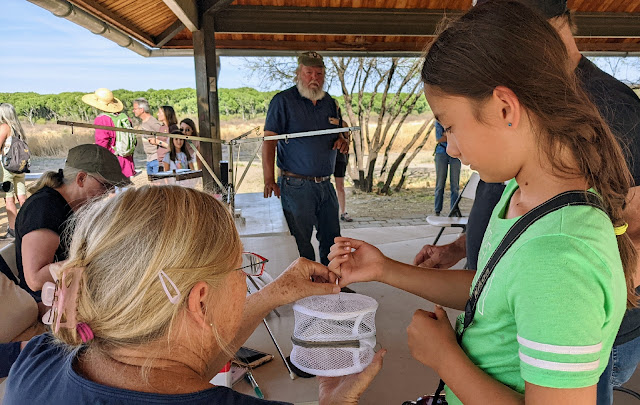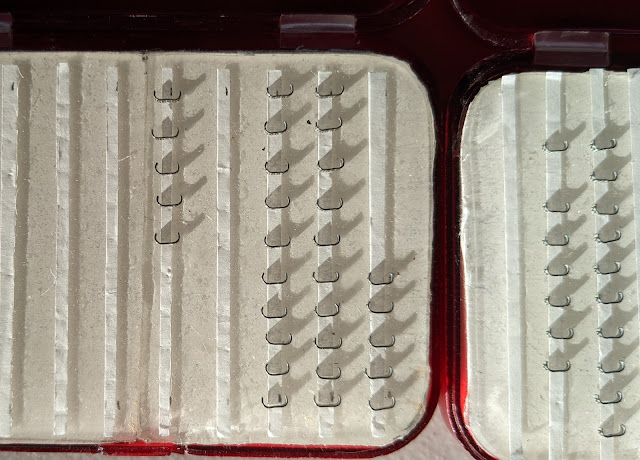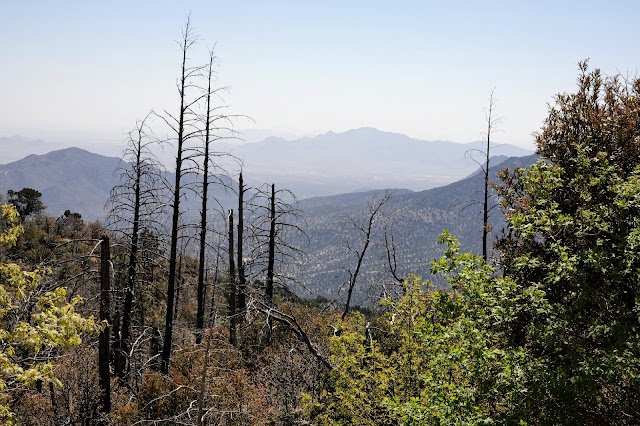We arrived to the (SABO) Southeastern Arizona Bird Observatory's station at the San Pedro House just before 4pm, and all seven rows of seats were already filled under the pavilion! The banders gave a presentation on why and how they band these tiny, amazing creatures. It's very different from banding songbirds as we saw in the Yukon. The biggest difference is in how they capture them. Songbirds are captured when they fly into a mist net stretched between two poles. Hummingbirds have the unique ability to move like helicopters, they can stop on a dime, fly up down, backwards and forwards. When faced with a mist net, they were able to stop just before running into it, then fly up and over. They tried a few other methods and found a bonnet trap around a feeder works best. Once a bird comes to the feeder, at the push of a button, the net drops over the entire feeder. It happens in one third of a second! The bird is then transferred into a smaller enclosure and carried to the banding station for processing. Asher and Journey were both invited to transport birds.
Nicole joined us and she even got to carry one! Think she was excited about it?
See the birds on the left ready to be processed? Here they will identify each bird. They've banded 10 different species of hummingbirds here over the past 27 years, but the day we were here in May, all of them were Black-chinned Hummingbirds. They will quickly record sex, age, measure their tail, bill and wing, and weigh them by folding a small piece of mesh over them and clipping to a scale. Black-chinned hummingbirds weigh about 3.6g. A penny weighs 3g. They will check their fat layer to indicate whether it is migrating or nesting nearby.
Finally they will fit a tiny metal band on its leg. The bands are so small and must be precisely sized, so they are sent to the bander to create. This business card-sized piece of aluminum alloy contains 100 bands! Once formed they will fit a safety pin.
Next they hand the bird to a SABO volunteer who offers the bird some sugar water. Before the event began, numbers were handed out to those who arrived early. Those people have an opportunity to release a bird if their number comes up. Unfortunately all numbers had been given before we arrived, however one gentleman left early and asked that his number be given to a child. The volunteer picked Journey!
Normally the volunteer would take you into the sun and let you take a few quick photos with your bird before placing it in your hand and letting it fly. It was determined that Journey's bird however had an egg inside and so it was important to release it as soon as possible. The bander invited Journey to the table and placed the hummingbird into her hand. It sat for a brief moment before speeding off to her nearby nest. What a cool experience for Journey! One that will be imprinted on her heart!
The entire process only takes about five minutes!
While waiting for a bird to be captured, the banders would field questions. We learned a lot during those breaks. The information gathered from banded birds is invaluable and includes learning about migration, lifespans, health of populations. In 2006 they recaptured a banded Black-chinned Hummingbird who had been banded 10 years prior!
Right up to the end they were eagerly encouraging more questions. You can tell these people are extremely passionate about what they do. I thoroughly enjoyed this event and highly recommend it for anyone, not just birders to see the process and learn how it benefits the birds and scientific community.
The public is invited to attend banding at the San Pedro House on Saturdays from the end of March to October 1, minus some days in between, so definitely check their schedule here. They also offer opportunities to attend private banding sessions in a different location.
While you're there, make a donation to support the wonderful work they are doing!
*Peak migration is mid-April to mid-May, and August. Arrive at 3 if you want to get a number for a chance to release a bird.





























































